| Konge og Kirke
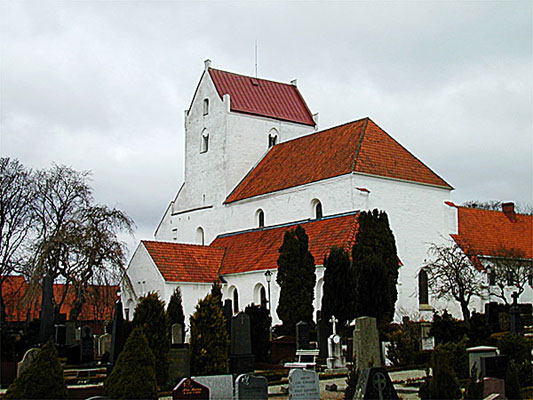
| | I tidlig middelalder var kongemagt og kirkemagt tætte allierede i opbygningen af en centralmagt og administration af riget.
Dalby kirke, en af de første stenkirker, var tæt knyttet til konge- og kirkemagt. |
Centralmagten
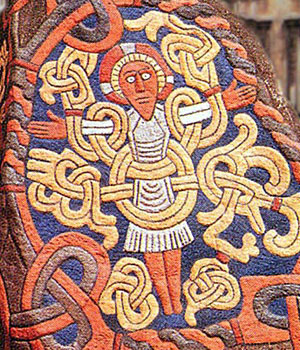
| | Opbygning af en stærk centralmagt gjorde det nødvendigt at kongemagten arbejdede nært sammen med kirken.
Denne alliance grundlægges tidligt, hvilket Harald Blåtands tekst på Den store Jellingesten vidner om: (Han) vandt sig alt Danmark og Norge og kristnede danerne.
Op gennem middelalderen var forholdet mellem kongemagt og kirke dog ofte præget af modsætninger. |
Opbygningen af en stabil centralmagt i den tidligste middelalder hviler på et tæt samarbejde imellem kirke- og kongemagt. Temaet slås an allerede på den berømte Store Jellingesten, hvor vi får at vide, at Harald Blåtand, der døde omkring 985, "Vandt sig alt Danmark og Norge og kristnede danerne".

Jellingestenene |
Borge og mønter
Etableringen af en vis centralmagt omkring dette tidspunkt bekræftes bl.a. af anlæggelsen af større militære anlæg som f.eks. Trelleborg på Vestsjælland, og tilsvarende ved Trelleborg i det sydøstlige Skåne.
Borganlæggene er antagelig kaserner, som måske er de knyttet til de oversøiske erobringstogter, der fortsætter ind i 1000-tallet, eller de kan være opført med henblik på lokalt forsvar. Under alle omstændigheder vidner det om en korrdineret indsats omkring militærvæsenet, og om centralmagtens underlæggelse og beherskelse af forskellige områder i riget.
Møntudstedelse er et andet tidligt vidnesbyrd om overordnet beherskelse af et område. I 1000-tallet begynder kongemagten at slå mønt bl.a. i Lund.

Kongens mønt | 
Knuds mønt | 
Knud den Hellige |
Kristendommens indførelse
Det er nok en tilsnigelse, når Harald Blåtand hævder at danerne blev kristnet før årtusindskiftet, men at kongemagten stræber efter at indføre og rodfæste kristendommen og dermed også styrke kongedømmets position vidner lidt senere tiltag om. I 1027 rejser Knud den Store(1018-1035) således til Rom, hvor han påskedag i Peterskirken overværer indsættelsen af en ny tysk-romersk kejser, formelt giver sig ind under denne, og selv fremstår som den store kristne fyrste fra Norden.
Rigets grænser
Stadigvæk er der dog tale om en brydningstid, hvor kristendommen endnu ikke er rodfæstet i samfundet og rigssamlingen fortsat pågår. Grænsen imellem Sverige og Danmark fastlægges først omkring 1070, hvor der opsættes seks grænsestene, heraf de fem på grænsen imellem Halland og Sverige og kun en enkelt på tværs i det nordlige Blekinge. Småland henligger endnu som en naturlig grænse af uigennemtrængelig skov.

Grænsesten |
Første beskrivelse af Norden
Omtrent på samme tidspunkt, altså omkring 1070, forfatter Adam af Bremen den første beskrivelse af Norden i værket De hamburgske Ærkebispers Historie. Interessen er at skildre Norden som ærkebispesædets missionsmark, men vi får tillige den første topografiske og historiske beskrivelse af Norden, som bygger på både skriftlige og mundtlige kilder, heriblandt udsagn fra den danske konge, Svend Estridsen(1047-1076).
Adam af Bremen fortæller i værket om Jylland, at det "er næsten ikke opdyrket nogetsteds og heller ikke egnet til menneskelig beboelse..." ,det"... er langt den mest grufulde landsdel, og man undgår gerne området: til lands på grund af mangel på korn, til vands på grund af faren for sørøvere."
Om Sjælland hedder det bl.a.: "Øen Sjælland, der ligger i det indre af Det baltiske Hav, er vældig af omfang. Sjælland, som er berømt for sine indbyggeres tapperhed og rige afgrøde, er to dagsrejser lang og næsten tilsvarende bred. Den største by er Roskilde -Danmarks kongesæde".
Tyngdepunkt i øst
Adam af Bremens beskrivelse kunne tyde på at tyngdepunktet i riget i anden halvdel af 1000-talllet er flyttet fra Østjylland til Sjælland, -måske på grund af de bedre produktionsbetingelser for landbruget i den østlige del af landet. Om Skåne hedder det, at det er "Danmarks skønneste landsdel, hvoraf den har fået sit navn. Den er svært væbnet med mænd, frugtbar på korn og handelsvarer" Hertil føjer han at Skåne også er fyldt med kirker, dobbelt så mange som på Sjælland, dvs. 300, men at Skåne endnu ikke har en biskop.
De første biskopper
Andre kilder beretter imidlertid, at der allerede i 1030 udnævnes en biskop over Sjælland, som også har myndighed over Skåne. Ved midten af 1000-tallet residerer der en biskop i Lund, men også i det nærliggende Dalby oprettes der omkring dette tidspunkt et bispesæde, som omfattede Østskåne, Blekinge og Bornholm.
Kongemagten knytter sig tilsyneladende tæt til bispesædet i Dalby idet Svend Estridsen(1047-74), som arbejder for oprettelsen af et særskilt ærkebispedømme i Norden, her lader opføre en kongsgård og en stenkirke, formodentlig Nordens ældste. Fra Dalby stammer formodentlig også den ældste kendte bog, der er udført i Norden, evangelieskriftet Dalbybogen.

Dalby kirke, Skåne | 
Basilika | 
Portalen | 
Krypten | 
Døbefonten |

Biskop Egino | 
Dalbybogen | 
Svend Estridsen |
Engelsk og tysk påvirkning
Den ornamentale stil i håndskriftet fra Dalby tyder på påvirkning fra det engelske område. Påvirkning fra den anden side af Nordsøen kan også påvises i kirkebyggeriet, f.eks. i Vejby kirke i Nordsjælland og giver anledning til spekulationer om rivalisering imellem angelsaksisk og nordtysk mission i Danmark.
Da biskoppen i Lund, Henrik, dør efter 1060 flytter Dalby-biskoppen Egino, der har tilknytning til ærkebispesædet i Hamburg-Bremen, til Lund og bliver biskop over Skånelandene, dvs. Skåne, Halland, Blekinge og Bornholm. I 1072 udnævner Svend Estridsen tyskeren Rickwald til biskop Lund. Selvom Rickwald var bandlyst og udstødt af kirken i Nordtyskland sidder han i 17 år uforstyrret på bispesædet i Lund. Det fortæller noget om, hvor løs forbindelsen til pavekirken endnu er.Lund Domkirke
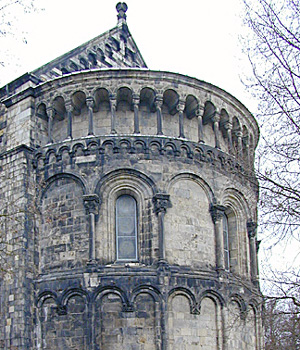
| | Knud den Hellige skænkede i 1085 jord med henblik på opførelse af en domkirke i Lund.
I 1104 anerkendes Norden første gang som en selvstændig kirkeprovins og omkring samme tidspunkt påbegyndes byggeriet af domkirken som står færdigbygget i 1145. |
I 1085 skænkede kong Knud den Hellige en stor gave til bispesædet i Lund. Gaven bestod i en række ejendomme på begge sider af Øresund. Desuden skulle Lunds Domkirke nu have skattepenge fra byen Lund, men også fra byerne Lomma og Helsingborg. Baggrunden var, at de danske byer betalte grundskat til kongen, eftersom han stod som ejer af de grunde, byerne blev opført på. Skatten blev kaldt for midsommerskatten. Det var dele af den skat, som Knud den Hellige skænkede til domkirken i Lund. Da midsommerskatten kun blev betalt af etablerede byer, står det klart, at Lund, Lomma og Helsingborg blev grundlagt før den 21. maj 1085, og altså hermed var Skånes første byer.

Lund i 1500-tallet | 
Lund Domkirke | 
S:t Laurentius | 
Astronomisk ur | 
Evangelieskrift |
Ærkebispesædet
I 1089 fik Lund en ny ærkebiskop, Asser, medlem af en af de fremtrædende stormandsslægter, Trued-slægten, og det var i hans tid, at Lund blev ærkebispesæde for hele Norden. Dette skete i 1103, og herefter påbegyndtes opførelsen af Lunds nye domkirke. Den blev bygget på den samme plads som Knud den Helliges domkirke, men skulle efterhånden få imponerende dimensioner, som passede bedre til et ærkebispesæde.
Kirken stod færdig i 1145, hvor den blev indviet af ærkebiskop Eskild, brorsøn til Asser og indsat som ærkebiskop i 1137. Lund var ærkestift for hele Norden frem til 1152, da Norge fik sin egen organisation og Sverige blev løsrevet fra Lunds ærkestift i 1164. Herefter var Lunds Domkirke udelukkende dansk domkirke og ærkebispesæde.
Bygmesteren
Som bygmester for det imponerende prestigebyggeri indkaldtes den lombardiske arkitekt, Donatus. Kirkerummet betragtes af mange, som noget af det ypperligste i den romanske kirkekunst.Omvendt er en yderst hårdhændet ydre restaurering i 1800 tallet beklaget fra mange sider.Karakteristisk for den lombardisk inspirerede kunst er en udstrakt brug af dekorative elementer på portaler figurer.

Sydindgangen | 
Sydportalen (detalje) | 
Lund | 
Krypten | 
Trolden Finn |
Kongen og stormændene
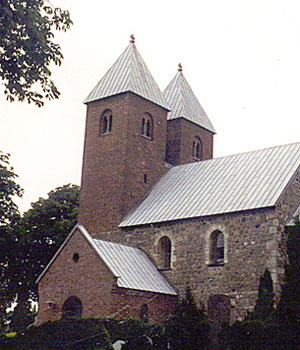
| | I opbygningen af riget arbejdede kongemagten tæt sammen med en række stormandsslægter, hvoraf den sjællandske Hvide-klan er den mest kendte.
Stormandsslægterne varetog rigets højeste embeder og satte sig også tydelige spor i det tidlige kirkebyggeri, som tillige vidner om bred international orientering og påvirkning. |
Stormændene
Knud den Hellige(-1086) var ikke, som navnet og den senere helgenkåring kunne antyde, specielt fredsommelig. I 1075, før sit valg til konge, iværksætter han således et erobringstogt mod England og igen i 1085 lægger han op til generobring af England, men vikingetogterne og nordsøimperiets tid er nu uigenkaldeligt forbi.
Knud den Helliges ambition er også i samarbejde med kirken at opbygge en styrket kongemagt. Han indfører den første kendte personskat (Nefgjald =næseskatten) og menes at være ophavsmand til bestemmelsen om at kongen ejer, hvad ingen anden ejer. I 1086 dræbes han af vrede undersåtter. Hvem der dræbte Knud den Hellige vides ikke bestemt, men meget tyder på at hans forsøg på at styrke kongemagten er stødt på modstand i befolkningen, blandt de frie bønder og i stormandskredse. Kongemagtens livtag med vikingetidens høvdingeslægter falder i første omgang tilsyneladende ud til disses fordel.
Stormandskirker
Rundt omkring i landet påbegyndes omkring samme tidspunkt et omfattende byggeri af stenkirker. Det antages at byggerierne i vid udstrækning forestås af lokale stormænd, som også har haft et personligt ejerskab til kirkerne. I enkelte tilfælde, f.eks. Fjenneslev Kirke på Midtsjælland ogJ ørlunde Kirke i Nordsjælland, kan der påvises en sammenhæng imellem kirkebyggeriet og en nærliggende stormandsbebyggelse. Enkelte steder findes også bevaret såkaldte stormandsgallerier, hvor kirkeejerne fra en ophøjet position har kunnet overvære gudstjenesten.

Riddermotiv | 
Fjenneslev Kirke | 
Kalundborg Kirke | 
Herskabsgalleri | 
Romansk portal |
Stifterbilleder
Vidnesbyrd om stormandslægternes rolle findes ligeledes i de såkaldte stifterbilleder i en række kirker rundt omkring i regionen, mest kendt måske det fra Fjenneslev Kirke på Sjælland. Billedet i Fjenneslev kirke forestiller ifølge overleveringen Asser Rig og fru Inge(Gørlev).
Asser Rig er søn af Skjalm Hvide(død henimod 1120), som lægger navn til den sjællandske stormandsklan, Hvide-slægten, der er den bedst kendte af stormandsslægterne. Asser Rig er selv far til den berømte ærkebiskop Absalon og hans broder Esbern Snare, der bl.a. grundlagde Kalundborg på vestsjælland.

Stifterbillede | 
Ingeborg | 
Esbern Snare | 
Stifterbillede | 
Vorherre |
Kongens embedsmænd
Kong Niels’ lange regeringsperiode fra 1104-34 betegner en konsolideringsperiode, hvor kirke- og kongemagt gensidigt befæster deres stilling i samfundet. Kongemagten synes i denne periode ikke at udfordre stormændene, men udbygger sine positioner ved udnævnelse af civile embedsmænd bl.a. en kammermester, der skulle tage sig af landets økonomi og pengevæsen, og senere kongens kansler, der var hans personlige sekretær. Denne stilling var i øvrigt forbeholdt biskoppen i Roskilde.
Til driften af kirkerne indføres omkring 1125 en tiendeafgift på produktionen, som tilfalder kirken og præsten, og betegner et skridt i retning af kirkens økonomiske integration i det middelaldersamfund, der er ved at tage form.
De militære funktioner skilles ud og overgår til ledingshæren og dens styrismænd. De frie mænds pligt til at stille til landets forsvar, ledingspligten, rækker tilbage til vikingetiden, men nu moderniseres ordningen så at sige. Kongens hird af stormænd forvandles efterhånden også til en kreds af lokale embedsmænd, eller ombudsmænd, der tog sig af den lokale forvaltning. Større enheder bestyredes af kongens jarler, mægtige stormænd, som f.eks. Skjalm Hvide, der var jarl over Sjælland. I Skåne havde kongen en særlig embedsmand, eller statholder, gælkeren.

Bastruptårnet |
Slaget ved Fotevik
Slaget ved Fotevik den 4. juni 1134 betød enden på Kong Niels lange regeringsperiode. Slaget er betegnet som et af de blodigste i middelalderens Danmark. Årsagen var en langvarig strid blandt efterkommerne af Svend Estridsen (1047-74), om hvem der skulle efterfølge Kong Niels på tronen.
Kong Niels, der var søn af Sven Estridsen, gik sammen med sin søn Magnus og en stor hær, i land ved Fotevik i den sydvestlige del af Skåne, for at gøre op med den nærmeste rival, Erik Emune, der var søn af kong Niels broder, Erik Ejegod. Erik Emune blev støttet af ærkebispen i Lund, Asser, samt en lejet tysk hær på ca.300 ryttere. Man mener i øvrigt, at det var første gang, der blev indsat en rytterhær i Danmark.
Resultatet blev at Kong Niels hær blev tilintegjort med katastrofale følger for den politiske stabilitet i Danmark. Sønnen Magnus faldt, og Kong Niels nåede kun akkurat selv at slippe væk. Tre uger efter blev han myrdet af utilfredse borgere i Slesvig. Blandt de faldne var en stor del af den danske administration, blandt andet: 5 bisper og ca. 60 præster. Det vides ikke, hvor mange af de "menige", der blev slået ihjel. Slaget ved Fotevik er beskrevet allerede i 1138 i Roskildekrøniken og lidt senere af Saxo.

Roskildekrøniken |
Lund, Danmarks hovedstad
Sejrherren efter slaget ved Fotevik, Erik Emune, lod sig nu hylde som konge på Sankt Libers høj ved Lund. Han bosatte sig i byen og gjorde den til Danmarks hovedstad. Erik Emune udviklede sig dog til en blodtørstig tyran og blev i 1137 myrdet på Tinget i Ribe af stormanden Sorteplov, der gennemborede ham med sin lanse.Biskop og kongekonflikt
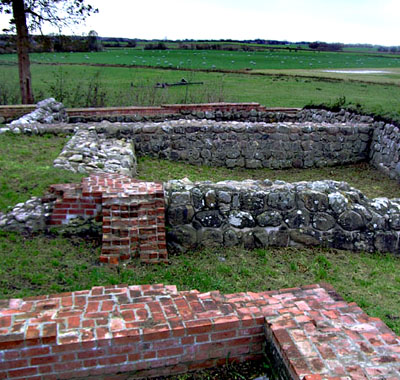
| | I nutiden syner Søborg slotsruin i Nordsjælland ikke af meget i landskabet. Men midt i 1100-tallet var den et vigtigt holdepunkt for Sjællands biskop.
Ved uoverensstemmelserne med ærkebispen Eskild overtog kong Valdemar den Store, den solidt byggede borg i 1161. |
Strid og forsoning
I 1135 modtog domkirken i Lund et gavebrev, der skænkede den jordegods på Amager og i Skåne samt ”immunitet og fuldstændig frihed for al kongen tilkommende ret”. Sådanne formuleringer omkring forholdet imellem den kirkelige og verdslige magt er ikke uden problemer og vidnesbyrd om uenigheder imellem kirken og den styrkede kongemagt omkring midten af 1100-tallet findes i Roskildekrøniken, den første sammenhængende danmarkshistorie, der er forfattet omkring 1140, formodentlig på foranledning af ærkebiskop Eskild.
Ærkebiskop Eskild
Eskild var stormand af Trugotslægten, havde i sin ungdom studeret i Heidelberg og Paris, var internationalt orienteret og havde personlige kontakter til pavekirkens ledende skikkelser. Eskild var en fremragende organisator. Han sørgede for udbygning af domkapitlerne, grundlagde ærkebispesædets by Aahus i det nordøstlige Skåne på jord skænket af kongen i 1149 og arbejdede også ihærdigt for indførelse af frie bispevalg og klostergrundlæggelser.
Eskild var internationalt orienteret og rustet til at tage del i den politiske magtkamp imellem kirkemagt og kongemagt, pave og kejser, den såkaldte investiturstrid, som handlede om kirkens ret til at udpege sine egne ledere, og som kommer til at præge hans tidsalder. Ærkebiskop Eskild bliver selv anledning til en længerevarende strid imellem de to parter, da han tages til fange af kejserens mænd i Tyskland under en rejse til Rom. Fra dette fangenskab skriver Eskild hjem i et for tiden sjældent, personligt dokument.
Eskild slipper dog fri og vender hjem igen, men omkring 1159 rager han uklar med kong Valdemar den Store(1157-82), der har besteget tronen i 1157. Kong Valdemar har formelt set givet sig ind under den tysk-romerske kejser og derfor kommer kirke- og kongemagt i Danmark til at stå på hver sin side i investiturstriden. Måske som konsekvens heraf drager Eskild i 1161 i eksil og vender først tilbage igen i 1168.

Bisp Eskild | 
Aahus | 
Søborg Slot | 
Plan over ruinen | 
Søborg kirke |
Krigerbispen Absalon
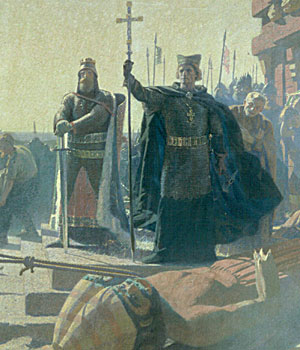
| | I anden halvdel af 1100-tallet opstår der et snævert samarbejde mellem kongemagt og kirke, mellem Valdemar den Store og ærkebiskop Absalon, som også tager aktivt del i togterne mod de vantro vendere i Nordtyskland. |
Valdemar den Store og Absalon
Valdemar den Store(1157-82) var opfostret hos Hvideslægten, der ejede og dominerde store dele af Sjælland. Året efter sin tronbestigelse gør han sin barndomskammerat Absalon af Hvideslægten til biskop i Roskilde, skønt han endnu ikke er fyldt de påbudte 30 år.
Hermed påbegyndes en alliance imellem kongemagt- og kirkemagt, som får vidtrækkende konsekvenser. Kong Valdemar formår bl.a. i samarbejde med Absalon at vende mange års indre svaghed og stridigheder til en ydre ekspansion og konsolidering.

Absalon | 
Højbro Plads |
Vendertogterne
De danske kyster var jævnligt hærget af vendiske invasioner og plyndringer sydfra, men i 1159 opbyder Valdemar og Absalon den sjællandske og skånske ledingsflåde til togt imod de vendiske kyster og det bliver til i alt 20 togter, kulminerende med togtet til Rügen i 1169, hvor øen erobres og med pavens velsignelse lægges ind under Roskildebispen.
Vendertogterne, der bliver Nordens svar på korstogene, var i realiteten også plyndringstogter, hvor man i stor målestok hjemførte hedenske slaver, der kunne anvendes som billig arbejdskraft i forbindelse med skovrydning, opdyrkning og de omfattende kirkebyggerier. Absalon havde selv en personlig slave, der blev frigivet ved hans død.

Arkonas tndtagelse | 
Arkona 1169 (Udsnit) | 
Absalons bispestav |
Den store kirkefest 1170
Kongemagten og Hvideslægtens indbyrdes alliance cementeres med en stor kirkefest i Ringsted i 1170, hvor kong Valdemars far, Knud Lavard, der er blevet helgenkåret, begraves i den nyopførte kongelige gravkirke. Det er en symbolladet begivenhed, hvor kongemagt og kirkemagt nærmest smelter sammen og kongen samtidig forsøger at befæste kongefamiliens stilling ved at udnævne sin søn Knud til efterfølger, selvom han formelt set først er endeligt valgt, når han er hyldet på de tre landsting, i Jylland, Skåne og på Sjælland.

Sct. Bents Kirke |
Eskild går i kloster
Ærkebiskoppen Eskild er også til stede ved begivenheden efter han er vendt tilbage fra sit eksil i 1168 og har forsonet sig med kongemagten. Først i 1177 nedlægger han sit embede som ærkebiskop, drager til cistercienserklosteret Clairveaux i Frankrig og afløses på posten af Absalon, der dermed meget usædvanligt for sin tid bliver biskop i både Roskilde og Lund. Måske er det et vidnesbyrd om et tæt forhold imellem Danmark og pavestolen, hvor Absalon er drivkraften i den nordiske mission i Baltikum.
Absalons kirker
Efter vendertogternes tid vender krigerbispen Absalon sig mod den indre ekspansion og udbygning af kirkesamfundet. Der er flere konkrete vidnesbyrd om Absalons medvirken til opførelser af nye stenkirker, f.eks. Tikøb kirke i Nordsjælland, formodentlig opført af munke fra det nærliggende Esrum Kloster, et tidligt eksempel på teglstensbyggeri i romansk stil. I Nørre Åsum kirke i det nordøstlige Skåne står en runesten med følgende indskrift:
"Krist, Marias søn, hjælp dem som byggede denne kirke, ærkebiskop Absalon og Esbjørn Mule".
Ligeledes i det nordøstlige Skåne har Absalon medvirket til opførelsen af Gumlöse Kirke, endnu et tidligt eksempel på teglstensbyggeri. Kirken indvies i 1197, hvor udover Absalon, der er ærkebiskop over hele Norden, også biskopperne fra Växjö i Sverige og Trondheim i Norge er til stede. I et stifterbrev nævnes således hans navn sammen med en lokal stormand, Ketil Trugotsen. Størstedelen af dokumentet er af en opremsning af alle de relikvier, i alt 28, der tilstedes den nye kirke.

Romansk teglstenskirke | 
Runeindskrift, | 
Gumlöse kirke | 
Østersøen ca. 1200 | 
Saxos manuskript |
Oprør i Skåne
I Skåne støder Absalon imidlertid på problemer, da han i 1180 med nye kirkelove vil indføre bispetiende og cølibat for præsterne. Oprøret i Skåne beskrives udførligt i 15. og 16. kapitel af Saxos Danmarkshistorie og i en kort version i Lundeårbogen der menes nedskrevet omkring år 1200.
”1180. I dette år opstod der en meget stor uenighed mellem skåningerne og ærkebiskop Absalon, så at han blev forjaget af Skåne og ikke på nogen måde ved egen hjælp kunne vende tilbage.
1181. I dette år vendte han langt om længe tilbage til landet med kraftig hånd og en stor hær støttet af kong Valdemars råd og dåd: han nedkæmpede sine fjender ved Anneløv og dræbte størstedelen af dem; de øvrige overgav sig, og derefter forsonede han sig med hele landet og genvandt sit ærkesæde i fred.”
Lundeårbogen gengiver i korte træk, hvad der beskrives nøjere hos Saxo,hvor der heller ikke lægges skjul på at ærkebiskoppen i første omgang må tage flugten. Imidlertid står der ikke meget om de konkrete årsager til uoverensstemmelserne. Dette uddybes imidlertid i Ældre sjællandske Krønike fra omkring 1300.
”Uenighed opstod mellem ærkebiskoppen og skåningerne. Grunden til denne uenighed siges at være indtruffet således. Ærkebiskop Absalon lod sjællænderne bestemme over ærkebiskoppelige ejendomme og opkrævninger, nemlig Esbern Snare, der var ærkebiskoppens bror, og hr. Sune, som var søn af hans farbror Ebbe, ligeledes Saxe, søn af Thorbern tillige med andre der stod ham nær. Disse forhold ærgrede skåningerne. Da der var forløbet en kort tid, påbød nævnte ærkebiskops opkrævere østskåningerne at de skulle slæbe hele træer og grene, som de havde fældet i skovene på steder hvortil trækdyrene ikke kunne komme, hen til en angiven plads. Skåningerne fandt sig ikke i at lade sig ydmyge i den grad og blev voldsomt vrede”.
Central og decentral magt.
Protesterne tager ifølge denne kilde udgangspunkt i ydmygelser af den skånske befolkning og vidner om protester imod kirkens overherredømme og forfordeling af Absalons sjællandske slægtninge. To år senere, efter kong Valdemars død, krones og salves hans søn og udpegede efterfølger Knud d.4.(1182-1202) som den første af kirken. Imidlertid nægter det skånske landsting at hylde ham, men denne gang trækker Absalon det længste strå, da han omringer landstinget og undertvinger de fremmødte.
Disse begivenheder skildrer med tydelighed uoverensstemmelser imellem den styrkede centralmagt og landsdelene og begynder at drage et skel imellem den tidligere middelalders, slægtssamfundets decentrale magt- og beslutningsstrukturer, og centralmagtens udvikling hen imod højmiddelalderen, hvor kongemagt og kirke fremstår som magtfulde og selvstændige enheder.Konsolidering
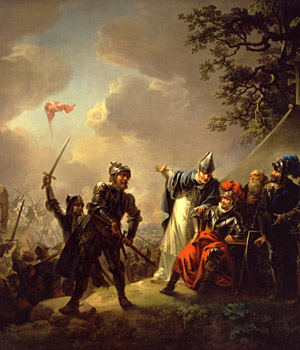
| | Valdemar Sejr 1202-1241 og ærkebiskop Anders Sunesen af Hvide-slægten fortsætter det tætte samarbejde.
Ekspansionen udstrækker sig til Baltikum, hvor der omkring det nuværende Estland i en periode oprettes to bispedømmer under Lunds ærkesæde. |
Anders Sunesen
Da Absalon dør i 1201 efterfølges han af slægtningen Anders Sunesen, en af fem brødre og stormænd der alle spiller fremtrædende roller i tiden under Valdemar Sejr (1202-41).
Anders Sunesens bror Peder blev biskop i Roskilde, grundlagde den nuværende domkirke efter fransk forbillede og opførte også den oprindelige Frue Kirke i København. Selv var Anders Sunesen domprovst i Roskilde og fungerende som følge heraf tillige som kongens kansler (sekretær) ved sin udnævnelse til ærkebiskop.
Den lærde kriger
Anders Sunesen er ligesom Absalon uddannet i udlandet, udover Paris tillige i Bologna, hvor Europas første universitet med speciale i retsvidenskab er etableret og endelig Oxford i England. Anders Sunesen er en højlærd og internationalt orienteret begavelse, der står parat til at fortsætte og udbygge det tætte samarbejde med kongemagten og da kong Knud d.4. dør og bisættes i Ringsted kan Anders Sunesen juledag 1202 krone den nye konge, Valdemar d.2. Sejr(1202-1241) i Lunds domkirke.
Anders Sunesen deltog ligesom sin forgænger og sammen med flere af sine brødre i udbygningen af det danske østersøimperium, bl.a. bestræbelserne på at missionere og kolonisere i Baltikum. Det lykkes i en kort periode, men i forbindelse med Valdemar Sejrs tilfangetagelse i Nordtyskland i 1223 må en lang række områder igen afgives.

Anders Sunesen |
Konsolideringens mand
Indadtil er rigsudviklingen karakteriseret ved en konsolidering af centralmagten således som det kommer til udtryk i Kong Valdemars Jordebog fra 1231, hvor kongens ejendomsret og relationer til stormandsslægterne fastlægges, og nedskrivningen af landskabslovene, senest Jyske Lov i 1241, samme år som Valdemar Sejr dør. I Jyske Lovs indledning formuleres i korte træk det afbalancerede forhold imellem kongemagt, kirke og stormænd omkring midten af 1200-tallet.
"Med lov skal land bygges, men ville enhver nøjes med sit eget og lade andre nyde samme ret, da behøvede man ikke nogen lov..."
"Den lov som kongen giver og landet vedtager, den kan han heller ikke ændre eller ophæve uden landets vilje, medmindre han åbenbart handler imod Gud..."
Det er kongen og landets høvdingers embede at overvåge domme og gøre ret og frelse dem, der tvinges med vold, såsom enker og værgeløse, børn, pilgrimme, udlændinge og fattige -dem overgår der tiest vold- og ikke lade slette mennesker, der ikke vil forbedre sig, leve i sit land; thi idet han straffer og dræber ugerningsmænd, da er han Guds tjener og landets vogter. Thi ligesom den hellige kirke styres af pave og biskop, således skal hvert land styres og værges af kongen eller hans embedsmænd. Derfor er også alle, der bor i hans land, skyldige at være ham hørige og lydige og underdanige, og til gengæld er han skyldig at give dem alle fred.”

Kong Valdemars Jordebog |
Lovsigeren
Anders Sunesen spillede også en fremtrædende rolle i bestræbelserne på at reformere og nedskrive lovgivningspraksis. Kendt er hans parafraser(fortolkninger) af Skånske Lov, og han menes også at være hovedmanden bag den såkaldte Skånske Manddrabsforordning fra år 1201.
Manddrab, eller rettere blodhævn, er et typisk udtryk for slægtssamfundets retsopfattelse, men i sin konsekvens og set fra middelaldersamfundets synspunkt samfundsnedbrydende. Derfor forsøger centralmagten at stramme reglerne. Med Den skånske Manddrabsforordning går kongemagten direkte ind i lovgivningsprocessen og forsøger at ændre slægtssamfundets retspraksis. Ved en kongelig rigslov i 1216 afskaffes jernbyrd som bevismiddel i retssager og ligeledes forsvinder edsafgørelser efterhånden til fordel for nævningeting.
Anders Sunesens ambition om at fastlægge forholdet imellem verdslig og kirkelig (kanonisk) retsopfattelse kommer til udtryk i hans fortolkning(parafrase) af Skånske Lov, hvor han kommenterer forhold vedrørende ægteskabet, som jo også er et kirkeligt sakramente og anliggende. Både kirke- og kongemagt har således interesse i at regulere adfærdsregler i forhold til slægtssamfundets ægteskabs- og jordpolitik.

Skånske Lov |
Leder og vogter
Anders Sunesens fortolkninger vidner om kirkens arbejde for at fremstå som åndeligt lederskab og moralens vogter og han arbejdede også ihærdigt for at gennemføre præstecølibatet, men tilsyneladende kun med ringe held.
I 1223 trækker Anders Sunesen sig fra ærkebispesædet ramt af sygdom, formodentlig spedalskhed, tilbringer sine sidste år på Ivö i det nordøstlige Skåne, dør i 1228 og ligger begravet i Lund domkirkes kor.

Anders Sunesens sarkofag | 
Anders Sunesen |
|